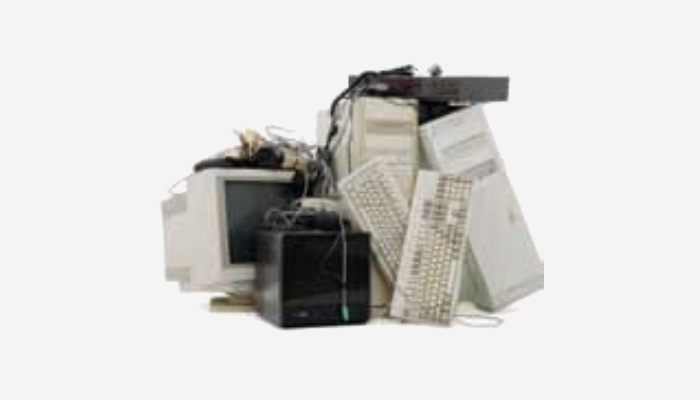
or

E-waste is rapidly posing a deep hazard for environment and health of mankind. Therefore, vital steps are necessary to check the possible threat.
The information and communication technology has led to phenomenal growth in the new electronic manufacturing industries in terms of volume and application. Digital development has become the new buzz word with a consequential giant environmental ‘footprint’. Booming usage of electronic and electrical equipment has created a new but very dangerous stream of waste, called “electronic–waste” or simply “e-waste”.
Every year, large numbers of unwanted computers, mobile phones, television sets and radio equipment are discarded, most of which either end up in landfills or unauthorised recycling ards. The challenges of managing e-waste in India are very different from those in developed countries because of its cultural diversity and economic disparity. Authorities seem to be unaware about the dangers.
E-waste is a real challenge to environmental and economic sustainability. A new regulatory framework is needed that embodies recycling standard, extending life of products and improving the market for second hand goods.
In India, there is no specific law to deal with e-waste. None of the existing environmental laws has any direct reference to ewaste. However, reference may be made to the provisions of The Hazardous Waste Management Rules 2003, as e-waste or its constituents may fall under the category of hazardous or nonhazardous waste, but the same cannot meet the formidable challenges posed by e-waste problem.
With the presence of deadly chemicals and toxic substances in the electronic gadgets, disposal of e-waste is becoming an environmental and health nightmare. Primitive recycling or disposal of e-waste to landfills and incinerators causes irreversible environmental damage by polluting water and soil and contaminating air. Long-term exposure of humans to high levels of hazardous chemicals damages the nervous systems, kidney, bones, reproductive and endocrine systems and some of them are carcinogenic and neurotoxin.
The major reason for the e-waste crisis is rapidly increasing e-waste volumes, both domestically generated as well as through imports. There are no accurate estimates of the quantity of e-waste generated and recycled. The problem is aggravated by low level of awareness amongst manufacturers and customers of the hazard of incorrect e-waste disposal.
Widespread e-waste recycling in the informal sector using rudimentary techniques, such as acid leaching and open air burning, results in severe environmental damage. Businesses sell discarded IT and other equipments to informal recyclers for quick money without realising the hazardous implications it causes to health and environment. The uneducated e-waste workers have little or no knowledge of toxins in e-waste and are exposed to serious health hazards.
Further, inefficient recycling processes result in substantial loses of material value. “Cherry-picking” by recyclers recovers precious metals and thereafter, they improperly dispose of the residue. Global brands are faltering on e-waste take back in India, despite the fact that these brands provide a voluntary take back service in other countries.
There is lack of coherent policy or specific legislation on the management of e-waste in India. The policy makers have shown little interest in drafting or implementing e-waste legislation. India needs strong regulations not only as an environmental protection measures but also covering the issue of developing national guidelines for formal recycling operations including producer’s responsibility, developing Wee rules, formulating standards and licensing procedures.
In March 2008, the Ministry of Environment & Forests (MoEF) released “voluntary guidelines” for e-waste management, but these are not legally binding. The need of hour is to draft deterrent legislation to curb the menace of e-waste. Recently (August 2009), the Manufacturers’ Association for Information Technology (MAIT) along with Greenpeace India (NGO) and Toxicslink (Civil Society Group) have submitted a copy of Draft Rules on e-waste to MoEF. This, if accepted, will be a first standalone policy on e-waste.
Many industry leaders are supporting the proposal (Toshiba, Nokia, Wipro, HCL, Acer, Sony Ericson to name a few). They have already begun a voluntary elimination of toxic chemicals and take back of obsolete products.
According to the Manufacturers’ Association for Information Technology (MAIT) Report (2008), India in 2007 generated 380,000 tonnes of e-waste, which is projected to grow to more than 800,000 tonnes by 2012 with a growth rate of 15%. The estimate includes 50,000 tonnes of e-waste imported from developed countries as charity for reuse, which mostly ends up in informal recycling yards either immediately or once the reuse product is discarded. However, the 2008 estimate puts it at 382,979 tonnes per year, which will go up to 1.6 million tonnes in the next three years.
Due to the increasing volumes of e-waste generated and the glaring inadequacies in its management, there is, more than ever, a necessity to evolve a sustainable solution for managing e-waste. Evolving a regulatory framework that mandates clear-cut responsibilities and requirement would go a long way in ensuring that there is adequate investment and appropriate action by responsible actors
Dr. Gitanjali Nain Gill is Associate Professor, Campus Law Centre, Faculty of Law at University of Delhi.

Lex Witness Bureau

Lex Witness Bureau

Lex Witness Bureau

For over 10 years, since its inception in 2009 as a monthly, Lex Witness has become India’s most credible platform for the legal luminaries to opine, comment and share their views. more...
Connect Us:


The Grand Masters - A Corporate Counsel Legal Best Practices Summit Series
www.grandmasters.in | 8 Years & Counting
The Real Estate & Construction Legal Summit
www.rcls.in | 8 Years & Counting
The Information Technology Legal Summit
www.itlegalsummit.com | 8 Years & Counting
The Banking & Finance Legal Summit
www.bfls.in | 8 Years & Counting
The Media, Advertising and Entertainment Legal Summit
www.maels.in | 8 Years & Counting
The Pharma Legal & Compliance Summit
www.plcs.co.in | 8 Years & Counting
We at Lex Witness strategically assist firms in reaching out to the relevant audience sets through various knowledge sharing initiatives. Here are some more info decks for you to know us better.
Copyright © 2020 Lex Witness - India's 1st Magazine on Legal & Corporate Affairs Rights of Admission Reserved